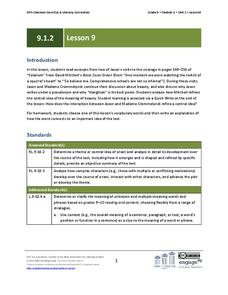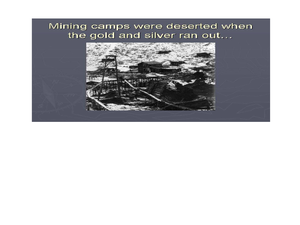EngageNY
Revising for Organization and Style: Exciting Endings
Young writers compose a gripping ending to their historical fiction narratives. Following the previous lesson plan, where learners wrote a bold beginning, class members examine exciting endings from a literary text. They then draft their...
EngageNY
Planning for Writing: Introduction and Conclusion of a Literary Argument Essay
After completing three body paragraphs of an argument essay about life's rules to live by from Bud, Not Buddy Christopher Paul Curtis, it's time to begin writing the introduction and conclusion. Independently, pupils draft the final two...
EngageNY
Grade 9 ELA Module 1, Unit 2, Lesson 7
Readers analyze David Mitchell's techniques for introducing and developing the mystery surrounding Madame Crommelynck in the "Solarium" chapter of his novel Black Swan Green.
EngageNY
Grade 9 ELA Module 1, Unit 2, Lesson 5
How does word choice influence the meaning and tone of a text? To answer this question, class members listen to a masterful reading of a passage from David Mitchell's Black Swan Green and then work with a partner to conduct a close...
EngageNY
Grade 9 ELA Module 1, Unit 2, Lesson 9
Class members continue their discussion of David Mitchell's Black Swan Green, focusing on how the author uses the conversation between Jason and Madame Crommelynck to refine his central idea of the meaning of beauty.
EngageNY
Grade 10 ELA Module 1: Unit 2, Lesson 4
Can a life gone wrong be blamed on a single childhood incident? Hundert, the narrator of "The Palace Thief," and readers struggle with this question as they ponder events in Ethan Canin's story.
EngageNY
Grade 9 ELA Module 4, Unit 1, Lesson 21
Class members read the chapter, "Serfs and Sweetness" from Sugar Changed the World, and identify the central idea that the development of beet sugar and modern farming technology changed the reliance on the plantation system and made...
EngageNY
Grade 9 ELA Module 4, Unit 1, Lesson 23
In "How We Researched and Wrote this Book," the final essay in Sugar Changed the World: A Story of Magic, Spice, Slavery, Freedom, and Science, authors Aronson and Budhos discuss their research methods and purpose in writing the text....
EngageNY
Grade 9 ELA Module 4, Unit 1, Lesson 17
How did the Demerara Rebellion of 1823, the death of Reverend John Smith, and the Emancipation Bill of 1833 that abolished slavery throughout the British Empire change the sugar industry? Class members examine how the authors of Sugar...
EngageNY
Grade 9 ELA Module 4, Unit 1, Lesson 16
The Sugar Changed the World chapter, "The Sound of Liberty," highlights how the differing attitudes toward the slave trade shifted the issue from an economic concern to a concern for human rights. The passage contrasts Thomas Jefferson's...
EngageNY
Grade 9 ELA Module 4, Unit 1, Lesson 5
What did the Crusades and plantations do with the global sugar spread? As class members continue their study of Sugar Changed the World, they examine how Crusaders brought sugar to Western Europe and how cultivating sugar led to the...
EngageNY
Grade 10 ELA Module 2: Unit 2, Lesson 2
What is a megalomaniac? Scholars discover the word's meaning as they read and analyze paragraphs seven and eight from Julia Alvarez's essay "A Genetics of Justice." They also read Mark Memmott's article "Remembering to Never Forget" and...
EngageNY
Grade 10 ELA Module 4: Unit 2, Lesson 4
Ambition, murder, nontraditional gender roles ... some problems just can't be fixed in marriage counseling. Learners discuss the relationship between Macbeth and Lady Macbeth. As a culminating activity, pupils analyze how the characters'...
EngageNY
Reading about Freaky Frogs: “The Glass Frog”
Freaky frogs are the focus of a lesson plan designed to boost reading comprehension skills using text features and asking and answering questions. Informational text and a poem supply scholars with animal-related vocabulary and facts. A...
EngageNY
Grade 11 ELA Module 1: Unit 2, Lesson 16
Using the resource, scholars read Act 3.3 of Shakespeare's Hamlet. They analyze two soliloquies and discuss how Shakespeare develops the characters.
EngageNY
End of Unit 2 Assessment, Part Two: Final Draft of Analytical Essay
What's one way to make a good essay great? Revise! Scholars revise their drafts from a previous lesson plan to help write their final polished analytical essays about the universal refugee experience. They also practice properly citing...
EngageNY
Close Reading: Paragraph 1 of “Refugee and Immigrant Children: A Comparison” (from “Refugee Children in Canada: Searching for Identity”)
What common challenges do refugees and immigrants face? Using the 9th lesson plan from the 20-part Grade 8 ELA Module 1, Unit 2 series, pupils read about the similarities between refugees' and immigrants' adaptation processes. Partners...
EngageNY
Building Background Knowledge: The Impending Fall of Saigon
Scholars read "Doc-Lap at Last" and participate in a Three Threes in a Row activity in which they answer three questions about the text in their rows. They then discuss the central idea of the text. Readers finish the lesson plan with a...
EngageNY
Revising the Informative Consumer Guide: Sentence Structure, Transitions, and Works Cited
Transitions are the glue that link paragraphs together. Pupils listen to a mini lesson plan on sentence structure and transitions and use what they learned to revise their informative consumer guides. Next, they self-assess their writing...
Curated OER
Feature Story/Interview Lesson Plan
Young journalists get a chance to practice their story writing skills by listening to an interview. Using the provided script, a class member interviews a treasure hunter (the instructor) while classmates take notes and then compose a...
Curated OER
Short Story Lesson Plan: “The Californian’s Tale”
Middle schoolers explore the theme of "The Californian's Tale" by Mark Twain. After reading Twain's short story, they identify and study its literary theme. Additionally, they analyze information and relationships in the piece, and write...
Curated OER
Short Story Lesson Plan: "The Californian's Tale"
Middle schoolers read the short story "The Californian's Tale" by Mark Twain and complete related activities. They discuss vocabulary for the story and complete a vocabulary matching definition activity. They complete writing activities...
Recorded Books
The Outsiders Lesson Plan
S. E. Hinton's The Outsiders is the anchor text for a how-to primer for using audiobooks in the classroom.
Jessica Winston
Gingerbread Friends Lesson Plan Guide
Full of activities for Jan Brett's story "Gingerbread Friends," this resource will get your kids in the mood for some snacks, fortify their need for vocabulary, and fill their minds with story elements.

























